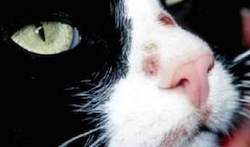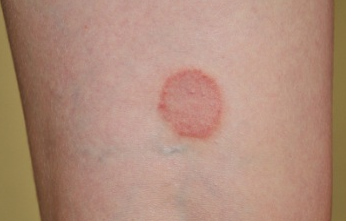Ringworm
 Ringworm is a condition related to the presence of filamentous fungi, dermatophytes, on the surface of the skin and the basis of dander (hair, hair, nail, claws) mammals.
Ringworm is a condition related to the presence of filamentous fungi, dermatophytes, on the surface of the skin and the basis of dander (hair, hair, nail, claws) mammals.
Ringworm is transmissible to humans. Although it is frequently diagnosed in the dog and cat, It remains the main source of contamination of human.
Transmission of dermatophytes
Ringworm is highly contagious. It is transmitted by passage of the spores of the fungus from one animal to another, or from animal to human. This transmission is:
– or by direct contact with the skin or hair of a stray animal
– or through the environment because the spores are very resistant to the surroundings (they can retain their infectivity to 1 year)
Clinical expression of ringworm
In animals
– In the dog and cat (in particular the kitten), circular lesions, well demarcated and containing more hair can be observed. In general, the animal reached by this form of ringworm scratching little.
– The dog, When parasitized by another species of dermatophyte, will be able to develop a protruding circular lesion, very inflammatory and sometimes purulent called "kerion". The latter is, most often, located on the animal's head.
– Ringworm, in adult cats, can take forms very different. It may in particular result in the appearance of many crusts on the skin accompanied by marked itching.
Finally, many cats do develop skin symptoms. They are called asymptomatic carriers : they can transmit ringworm a human being although their coat has no visible lesions. In this case, the contamination of a human living in contact with the cat is sometimes the only element which allows to suspect the presence of the fungus in the animal.
In humans
In contact with human skin, the spores germinate and cause the appearance of round lesions, well delimited, reddish and cause itching.
It's lesions "herpes vine"
These lesions occur mainly on areas of the body in frequent contact with animals (hands, wrists, arm, neck, face).
Children are much more often affected than adults.
The CAT is the main source of contamination of the human of the fact :
– his way of life ( access to many places in the House, sessions, games and frequent caresses with the owners )
– of possible asymptomatic ( It then drops of very many spores contaminating into housing until the contamination of one of the family members allow to highlight the presence of the fungus within the home)
Diagnosis
The diagnosis of ringworm may be performed by several types of exams:
– A review of the coat with a special light = Wood lamp examination (bearing hairs of spores appear fluorescent review)
– A microscopic examination of the hair by the veterinarian
– Cultivation of special medium hair (It's the safest, and sometimes the only way to reveal the presence of fungi)
Treatment
Treatment should be undertaken as quickly as possible in order to limit the spread of spores in the environment and human contamination.
It consists of the regular application of antimycotic solution on the coat of the animal, associated with an oral treatment. These treatments, due to the resistance of the spores, must generally be made for several weeks. The animal is considered "cured" when two fungal cultures carried out at 15 an interval of days prove negative.
The spores are very resistant to the surroundings, disinfection of the habitat must be associated with the treatment of the animal:
– It should be vacuumed frequently and destroy bags.
– The application of antimycotic solution (enilconazole-based) even the use of smoke for the destruction of spores in the environment will allow to eliminate spores present in the home.
Contaminated man must consult a dermatologist in order to receive appropriate treatment.
© Copyright Vetup 2011

